In Situ Reduced Multi-Core Yolk–Shell Co@C Nanospheres for Broadband Microwave Absorption
Abstract
:1. Introduction
2. Materials and Methods
2.1. Materials
2.2. Synthesis of Co3O4 Nanospheres
2.3. Synthesis of Co@C Nanospheres
2.4. Characterization
3. Results and Discussion
4. Conclusions
Author Contributions
Funding
Institutional Review Board Statement
Informed Consent Statement
Data Availability Statement
Conflicts of Interest
References
- Kong, L.B.; Li, Z.W.; Liu, L.; Huang, R.; Abshinova, M.; Yang, Z.H.; Tang, C.B.; Tan, P.K.; Deng, C.R.; Matitsine, S. Recent progress in some composite materials and structures for specific electromagnetic applications. Int. Mater. Rev. 2013, 58, 203–259. [Google Scholar] [CrossRef]
- Landy, N.I.; Sajuyigbe, S.; Mock, J.J.; Smith, D.R.; Padilla, W.J. Perfect metamaterial absorber. Phys. Rev. Lett. 2008, 100, 207402. [Google Scholar] [CrossRef]
- Watts, C.M.; Liu, X.; Padilla, W.J. Metamaterial electromagnetic wave absorbers. Adv. Mater. 2012, 24, OP98–OP120. [Google Scholar] [CrossRef]
- Imani, M.F.; Smith, D.R.; del Hougne, P. Perfect Absorption in a Disordered Medium with Programmable Meta-Atom Inclusions. Adv. Funct. Mater. 2020, 30, 2005310. [Google Scholar] [CrossRef]
- Dong, X.L.; Zhang, X.F.; Huang, H.; Zuo, F. Enhanced microwave absorption in Ni/polyaniline nanocomposites by dual dielectric relaxations. Appl. Phys. Lett. 2008, 92, 013127. [Google Scholar] [CrossRef]
- Huang, M.Q.; Wang, L.; Pei, K.; You, W.B.; Yu, X.F.; Wu, Z.C.; Che, R.C. Multidimension-Controllable Synthesis of MOF-Derived Co@N-Doped Carbon Composite with Magnetic-Dielectric Synergy toward Strong Microwave Absorption. Small 2020, 16, 2000158. [Google Scholar] [CrossRef] [PubMed]
- Ge, J.W.; Liu, S.M.; Liu, L.; Cui, Y.; Meng, F.D.; Li, Y.X.; Zhang, X.F.; Wang, F.H. Optimizing the electromagnetic wave absorption performance of designed hollow CoFe2O4/CoFe@C microspheres. J. Mater. Sci. Technol. 2021, 81, 190–202. [Google Scholar] [CrossRef]
- Liu, J.; Cao, M.S.; Luo, Q.; Shi, H.L.; Wang, W.Z.; Yuan, J. Electromagnetic property and tunable microwave absorption of 3D nets from nickel chains at elevated temperature. ACS Appl. Mater. Interfaces 2016, 8, 22615–22622. [Google Scholar] [CrossRef]
- Srikar, K.; Dwarapudi, S.; Kumar, D.; Sinha, G.R.; Moon, A.P. Carbonyl iron powders as absorption material for microwave interference shielding: A review. J. Alloys Compd. 2020, 853, 157251. [Google Scholar]
- Aslam, M.A.; Ding, W.; ur Rehman, S.; Hassan, A.; Bian, Y.C.; Liu, Q.C.; Sheng, Z.G. Low cost 3D bio-carbon foams obtained from wheat straw with broadened bandwidth electromagnetic wave absorption performance. Appl. Surf. Sci. 2021, 543, 148785. [Google Scholar] [CrossRef]
- Houbi, A.; Aldashevich, Z.A.; Atassi, Y.; Telmanovna, Z.B.; Saule, M.; Kubanych, K. Microwave absorbing properties of ferrites and their composites: A review. J. Magn. Magn. Mater. 2021, 529, 167839. [Google Scholar] [CrossRef]
- Bandaru, S.; Murthy, N.; Kulkarni, R.; English, N.J. Magnetic ferrite/carbonized cotton fiber composites for improving electromagnetic absorption properties at gigahertz frequencies. J. Mater. Sci. 2021, 86, 127–138. [Google Scholar]
- Du, Y.C.; Liu, W.W.; Qiang, R.; Wang, Y.; Han, X.J.; Ma, J.; Xu, P. Shell thickness-dependent microwave absorption of core-shell Fe3O4@C composites. ACS Appl. Mater. Interfaces 2014, 6, 12997–13006. [Google Scholar] [CrossRef]
- Tian, C.H.; Du, Y.C.; Cui, C.S.; Deng, Z.L.; Xue, J.L.; Xu, P.; Qing, R.; Wang, Y.; Han, X.J. Synthesis and microwave absorption enhancement of yolk-shell Fe3O4@C microspheres. J. Mater. Sci. 2017, 52, 6349–6361. [Google Scholar] [CrossRef]
- Liu, J.W.; Cheng, J.; Che, R.C.; Xu, J.J.; Liu, M.M.; Liu, Z.W. Synthesis and microwave absorption properties of yolk-shell microspheres with magnetic iron oxide cores and hierarchical copper silicate shells. ACS Appl. Mater. Interfaces 2013, 5, 2503–2509. [Google Scholar] [CrossRef]
- Zhang, X.F.; Guan, P.F.; Dong, X.L. Transform between the permeability and permittivity in the close-packed Ni nanoparticles. Appl. Phys. Lett. 2010, 97, 033107. [Google Scholar] [CrossRef]
- Bhattacharjee, Y.; Bose, S. Core-Shell Nanomaterials for Microwave Absorption and Electromagnetic Interference Shielding: A Review. ACS Appl. Nano Mater. 2021, 4, 949–972. [Google Scholar] [CrossRef]
- Qiao, M.T.; Lei, X.F.; Ma, Y.; Tian, L.D.; He, X.W.; Su, K.H.; Zhang, Q.Y. Application of yolk-shell Fe3O4@N-doped carbon nanochains as highly effective microwave-absorption material. Nano Res. 2018, 11, 1500–1519. [Google Scholar] [CrossRef]
- Moon, G.D. Yolk–shell nanostructures: Syntheses and applications for lithium-ion battery anodes. Nanomaterials 2020, 10, 675. [Google Scholar] [CrossRef] [Green Version]
- Deng, Z.H.; He, S.R.; Wang, W.; Xu, M.Z.; Zheng, H.Y.; Yan, J.F.; Zhang, W.X.; Yun, J.N.; Zhao, W.; Gan, P.Y. Construction of hierarchical SnO2@Fe3O4 nanostructures for efficient microwave absorption. J. Magn. Magn. Mater. 2020, 498, 166224. [Google Scholar] [CrossRef]
- Chen, X.L.; Jia, Z.; Feng, A.L.; Wang, B.B.; Tong, X.H.; Zhang, C.H.; Wu, G.L. Hierarchical Fe3O4@carbon@MnO2 hybrid for electromagnetic wave absorber. J. Colloid Interface Sci. 2019, 553, 465–474. [Google Scholar] [CrossRef] [PubMed]
- Gao, S.T.; Zhang, Y.C.; Xing, H.L.; Li, H.X. Controlled reduction synthesis of yolk-shell magnetic@void@C for electromagnetic wave absorption. Chem. Eng. J. 2020, 387, 124149. [Google Scholar] [CrossRef]
- Liu, Q.H.; Cao, Q.; Bi, H.; Liang, C.Y.; Yuan, K.P.; She, W.; Yang, Y.J.; Che, R.C. CoNi@SiO2@TiO2 and CoNi@Air@TiO2 microspheres with strong wideband microwave absorption. Adv. Mater. 2016, 28, 486–490. [Google Scholar] [CrossRef]
- Wang, L.; Yu, X.F.; Li, X.; Zhang, J.; Wang, M.; Che, R.C. MOF-derived yolk-shell Ni@C@ZnO Schottky contact structure for enhanced microwave absorption. Chem. Eng. J. 2020, 383, 123099. [Google Scholar] [CrossRef]
- Chen, Y.; Chen, H.R.; Guo, L.M.; He, Q.J.; Chen, F.; Zhou, J.; Feng, J.W.; Shi, J.L. Hollow/rattle-type mesoporous nanostructures by a structural difference-based selective etching strategy. ACS Nano 2010, 4, 529–539. [Google Scholar] [CrossRef] [PubMed]
- Zheng, N.C.; Ouyang, T.; Chen, Y.; Wang, Z.; Che, D.Y.; Liu, Z.Q. Ultrathin CdS shell-sensitized hollow S-doped CeO2 spheres for efficient visible-light photocatalysis. Catal. Sci. Technol. 2019, 9, 1357–1364. [Google Scholar] [CrossRef]
- Hong, Y.Y.; Pu, C.L.; Zhao, H.L.; Sheng, Q.Y.; Zhan, Q.L.; Lan, M.B. Yolk-shell magnetic mesoporous TiO2 microspheres with flowerlike NiO nanosheets for highly selective enrichment of phosphopeptides. Nanoscale 2017, 9, 16764–16772. [Google Scholar] [CrossRef]
- Liu, J.W.; You, W.B.; Yu, J.Y.; Liu, X.G.; Zhang, X.F.; Guo, J.J.; Che, R.C. Electron holography of yolk-shell Fe3O4@mSiO2 microspheres for use in microwave absorption. ACS Appl. Nano Mater. 2019, 2, 910–916. [Google Scholar] [CrossRef]
- Qi, J.; Zhao, K.; Li, G.D.; Gao, Y.; Zhao, H.J.; Yu, R.B.; Tang, Z.Y. Multi-shelled CeO2 hollow microspheres as superior photocatalysts for water oxidation. Nanoscale 2014, 6, 4072–4077. [Google Scholar] [CrossRef] [Green Version]
- Shen, L.F.; Yu, L.; Yu, X.Y.; Zhang, X.G.; Lou, X.W. Self-templated formation of uniform NiCo2O4 hollow spheres with complex interior structures for lithium-ion batteries and supercapacitors. Angew. Chem. Int. Ed. 2015, 54, 1868–1872. [Google Scholar] [CrossRef]
- Shi, L.; He, Y.R.; Hu, Y.W.; Wang, X.Z.; Jiang, B.C.; Huang, Y.M. Synthesis of size-controlled hollow Fe3O4 nanospheres and their growth mechanism. Particuology 2020, 49, 16–23. [Google Scholar] [CrossRef]
- Liu, P.B.; Gao, S.; Zhang, G.Z.; Huang, Y.; You, W.B.; Che, R.C. Hollow Engineering to Co@N-Doped Carbon Nanocages via Synergistic Protecting-Etching Strategy for Ultrahigh Microwave Absorption. Adv. Funct. Mater. 2021, 2102812. [Google Scholar] [CrossRef]
- Li, Z.N.; Han, X.J.; Ma, Y.; Liu, D.W.; Wang, Y.H.; Xu, P.; Li, C.L.; Du, Y.C. MOFs-derived hollow Co/C microspheres with enhanced microwave absorption performance. ACS Sustain. Chem. Eng. 2018, 6, 8904–8913. [Google Scholar] [CrossRef]
- Chen, G.Z.; Xu, C.X.; Song, X.Y.; Zhao, W.; Ding, Y.; Sun, S.X. Interface reaction route to two different kinds of CeO2 nanotubes. Inorg. Chem. 2008, 47, 723–728. [Google Scholar] [CrossRef]
- Chen, G.Z.; Sun, S.X.; Sun, X.; Fan, W.L.; You, T. Formation of CeO2 nanotubes from Ce(OH)CO3 nanorods through kirkendall diffusion. Inorg. Chem. 2009, 48, 1334–1338. [Google Scholar] [CrossRef]
- Yue, Q.; Li, J.L.; Zhang, Y.; Cheng, X.W.; Chen, X.; Pan, P.P.; Su, J.C.; Elezatahry, A.A.; Alghamdi, A.; Deng, Y.H.; et al. Plasmolysis-inspired nanoengineering of functional yolk-shell microspheres with magnetic core and mesoporous silica shell. J. Am. Chem. Soc. 2017, 139, 15486–15493. [Google Scholar] [CrossRef]
- Xu, P.F.; Yu, R.B.; Ren, H.; Zong, L.B.; Chen, J.; Xing, X.R. Hierarchical nanoscale multi-shell Au/CeO2 hollow spheres. Chem. Sci. 2014, 5, 4221–4226. [Google Scholar] [CrossRef]
- Qin, M.; Zhang, L.M.; Zhao, X.R.; Wu, H.J. Defect Induced Polarization Loss in Multi-Shelled Spinel Hollow Spheres for Electromagnetic Wave Absorption Application. Adv. Sci. 2021, 8, 2004640. [Google Scholar] [CrossRef]
- Zhao, B.; Guo, X.Q.; Zhao, W.Y.; Deng, J.S.; Fan, B.B.; Shao, G.; Bai, Z.Y.; Zhang, R. Facile synthesis of yolk–shell Ni@void@SnO2 (Ni3Sn2) ternary composites via galvanic replacement/Kirkendall effect and their enhanced microwave absorption properties. Nano Res. 2017, 10, 331–343. [Google Scholar] [CrossRef]
- Shi, X.F.; You, W.B.; Zhao, Y.H.; Zhao, Y.H.; Li, X.; Shao, Z.Z.; Che, R.C. Multi-scale magnetic coupling of Fe@SiO2@C–Ni yolk@triple-shell microspheres for broadband microwave absorption. Nanoscale 2019, 11, 17270–17276. [Google Scholar] [CrossRef]
- Wei, Y.Z.; Yang, N.L.; Huang, K.K.; Wan, J.W.; You, F.F.; Yu, R.B.; Feng, S.H.; Wang, D. Steering hollow multishelled structures in photocatalysis: Optimizing surface and mass transport. Adv. Mater. 2020, 32, 2002556. [Google Scholar] [CrossRef] [PubMed]
- Qi, J.; Lai, X.Y.; Wang, J.Y.; Tang, H.J.; Ren, H.; Yang, Y.; Jin, Q.; Zhang, L.J.; Yu, R.B.; Ma, G.H.; et al. Multi-shelled hollow micro-/nanostructures. Chem. Soc. Rev. 2015, 44, 6749–6773. [Google Scholar] [CrossRef] [PubMed]
- Zhao, Y.; Jiang, L. Hollow micro/nanomaterials with multilevel interior structures. Adv. Mater. 2009, 21, 3621–3638. [Google Scholar] [CrossRef]
- Ding, D.; Wang, Y.; Li, X.D.; Qiang, R.; Xu, P.; Chu, W.L.; Han, X.J.; Du, Y.C. Rational design of core-shell Co@C microspheres for high-performance microwave absorption. Carbon 2017, 111, 722–732. [Google Scholar] [CrossRef]
- Qiao, Z.A.; Guo, B.K.; Binder, A.J.; Chen, J.H.; Veith, G.M.; Dai, S. Controlled synthesis of mesoporous carbon nanostructures via a “silica-assisted” strategy. Nano Lett. 2013, 13, 207–212. [Google Scholar] [CrossRef]
- Meng, X.; Liu, Y.Q.; Han, G.H.; Yang, W.W.; Yu, Y.S. Three-dimensional (Fe3O4/ZnO)@C Double-core@shell porous nanocomposites with enhanced broadband microwave absorption. Carbon 2020, 162, 356–364. [Google Scholar] [CrossRef]
- Teng, Z.; Zeng, S.F.; Feng, W.L.; Zhu, L.N.; Tan, Y.Q.; Han, X.C.; Chen, C.; Zhang, H.B. Facile synthesis and enhanced microwave absorption properties of Fe-Fe3C@C composites. J. Mater. Sci. Mater. Electron. 2019, 30, 14573–14579. [Google Scholar] [CrossRef]
- Lv, H.L.; Ji, G.B.; Liu, W.; Zhang, H.Q.; Du, Y.W. Achieving hierarchical hollow carbon@Fe@Fe3O4 nanospheres with superior microwave absorption properties and lightweight features. J. Mater. Chem. C 2015, 3, 10232–10241. [Google Scholar] [CrossRef]
- Liu, D.W.; Qiang, R.; Du, Y.C.; Tian, C.H.; Han, X.J. Prussian blue analogues derived magnetic FeCo alloy/carbon composites with tunable chemical composition and enhanced microwave absorption. J. Colloid Interface Sci. 2018, 514, 10–20. [Google Scholar] [CrossRef]
- Zhou, C.H.; Wu, C.; Yan, M. Hierarchical FeCo@MoS2 nanoflowers with strong electromagnetic wave absorption and broad bandwidth. ACS Appl. Nano Mater. 2018, 1, 5179–5187. [Google Scholar] [CrossRef]
- Wang, C.X.; Wang, B.B.; Cao, X.; Zhao, J.W.; Chen, L.; Shan, L.G.; Wang, H.N.; Wu, G.G. 3D flower-like Co-based oxide composites with excellent wideband electromagnetic microwave absorption. Compos. B Eng. 2021, 205, 108529. [Google Scholar] [CrossRef]
- Meng, F.B.; Wang, H.G.; Huang, F.; Guo, Y.F.; Wang, Z.Y.; Hui, D.; Zhou, Z.W. Graphene-based microwave absorbing composites: A review and prospective. Compos. B Eng. 2018, 137, 260–277. [Google Scholar] [CrossRef]
- Jia, Z.R.; Lan, D.; Lin, K.J.; Qin, M.; Kou, K.C.; Wu, G.L.; Wu, H.J. Progress in low-frequency microwave absorbing materials. J. Mater. Sci. Mater. Electron. 2018, 29, 17122–17136. [Google Scholar] [CrossRef]
- Shi, X.F.; You, W.B.; Li, X.; Wang, L.; Shao, Z.Z.; Che, R.C. In-situ regrowth constructed magnetic coupling 1D/2D Fe assembly as broadband and high-efficient microwave absorber. Chem. Eng. J. 2021, 415, 128951. [Google Scholar] [CrossRef]
- Wang, L.; Yu, X.F.; Huang, M.Q.; You, W.B.; Zeng, Q.W.; Zhang, J.; Liu, X.H.; Wang, M.; Che, R.C. Orientation growth modulated magnetic-carbon microspheres toward broadband electromagnetic wave absorption. Carbon 2021, 172, 516–528. [Google Scholar] [CrossRef]
- Li, G.M.; Wang, L.C.; Li, W.X.; Yao, X. Fe-, Co-, and Ni-Loaded Porous Activated Carbon Balls as Lightweight Microwave Absorbents. ChemPhysChem 2015, 16, 3458–3467. [Google Scholar] [CrossRef]
- Qiao, M.T.; Wei, D.; He, X.W.; Lei, X.F.; Wei, J.; Zhang, Q.Y. Novel yolk-shell Fe3O4@void@SiO2@PPy nanochains toward microwave absorption application. J. Mater. Sci. 2021, 56, 1312–1327. [Google Scholar] [CrossRef]
- Yang, Z.H.; Li, M.; Yang, L.J.; Liu, J.C.; Wang, Y.H.; He, Q.J. Constructing uniform Fe3O4@C@MnO2 microspheres with yolk-shell interior toward enhancement in microwave absorption. J. Alloys Compd. 2020, 817, 152795. [Google Scholar] [CrossRef]
- Ibrahim, I.R.; Matori, K.A.; Ismail, I.; Awang, Z.; Rusly, S.N.A.; Nazlan, R.; Idris, F.M.; Zulkimi, M.M.M.; Abdullah, N.H.; Mustaffa, M.S.; et al. A study on microwave absorption properties of carbon black and Ni0.6Zn0.4Fe2O4 nanocomposites by tuning the matching-absorbing layer structures. Sci. Rep. 2020, 10, 3135. [Google Scholar] [CrossRef] [Green Version]

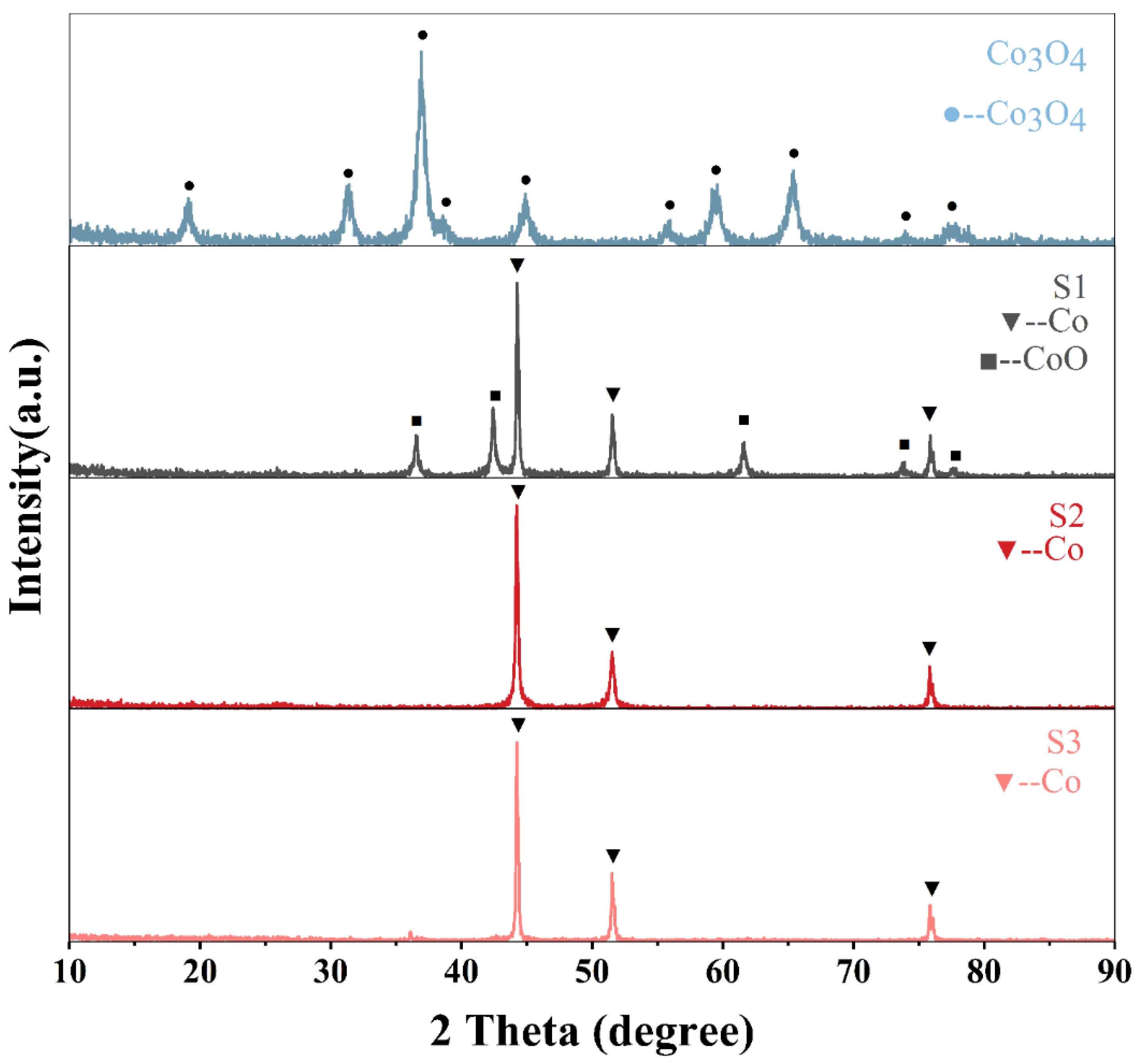
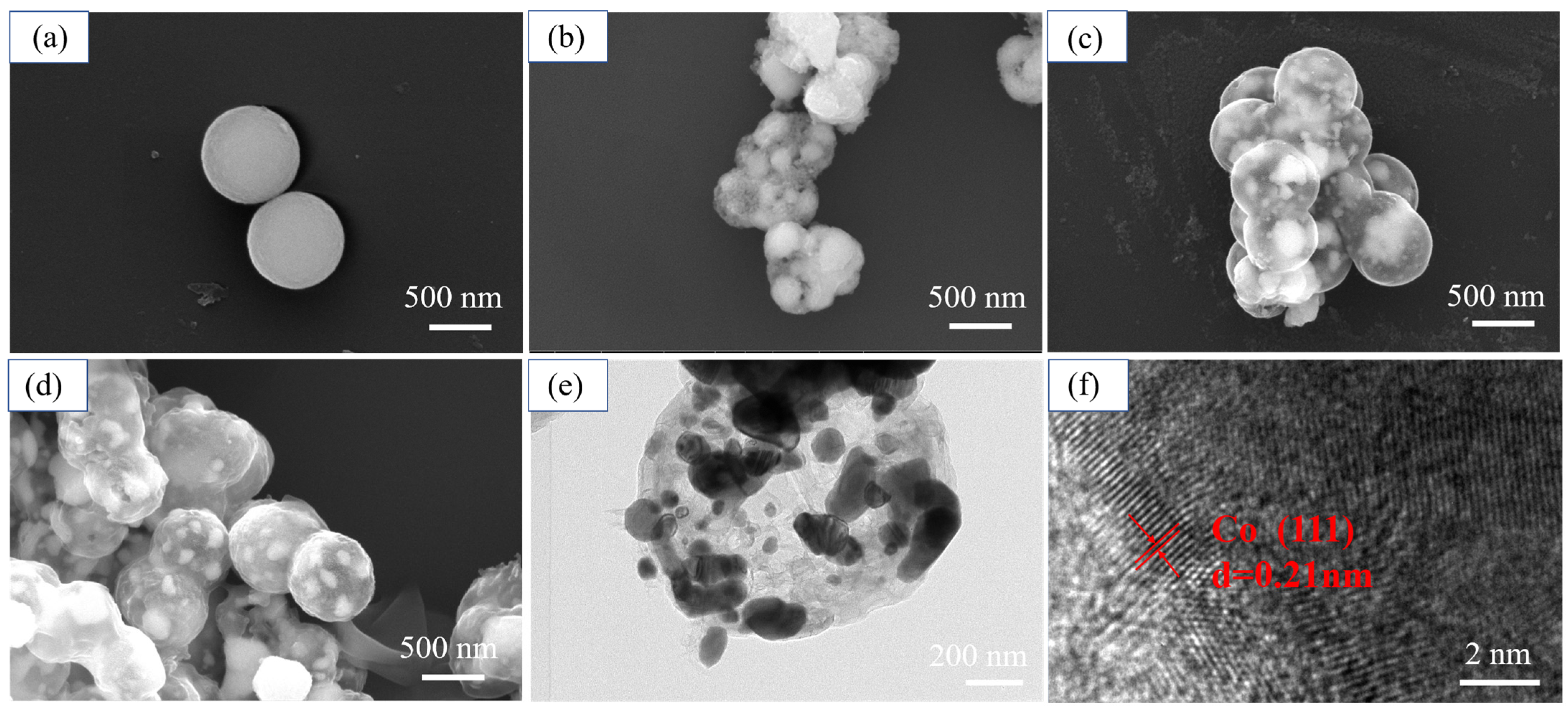
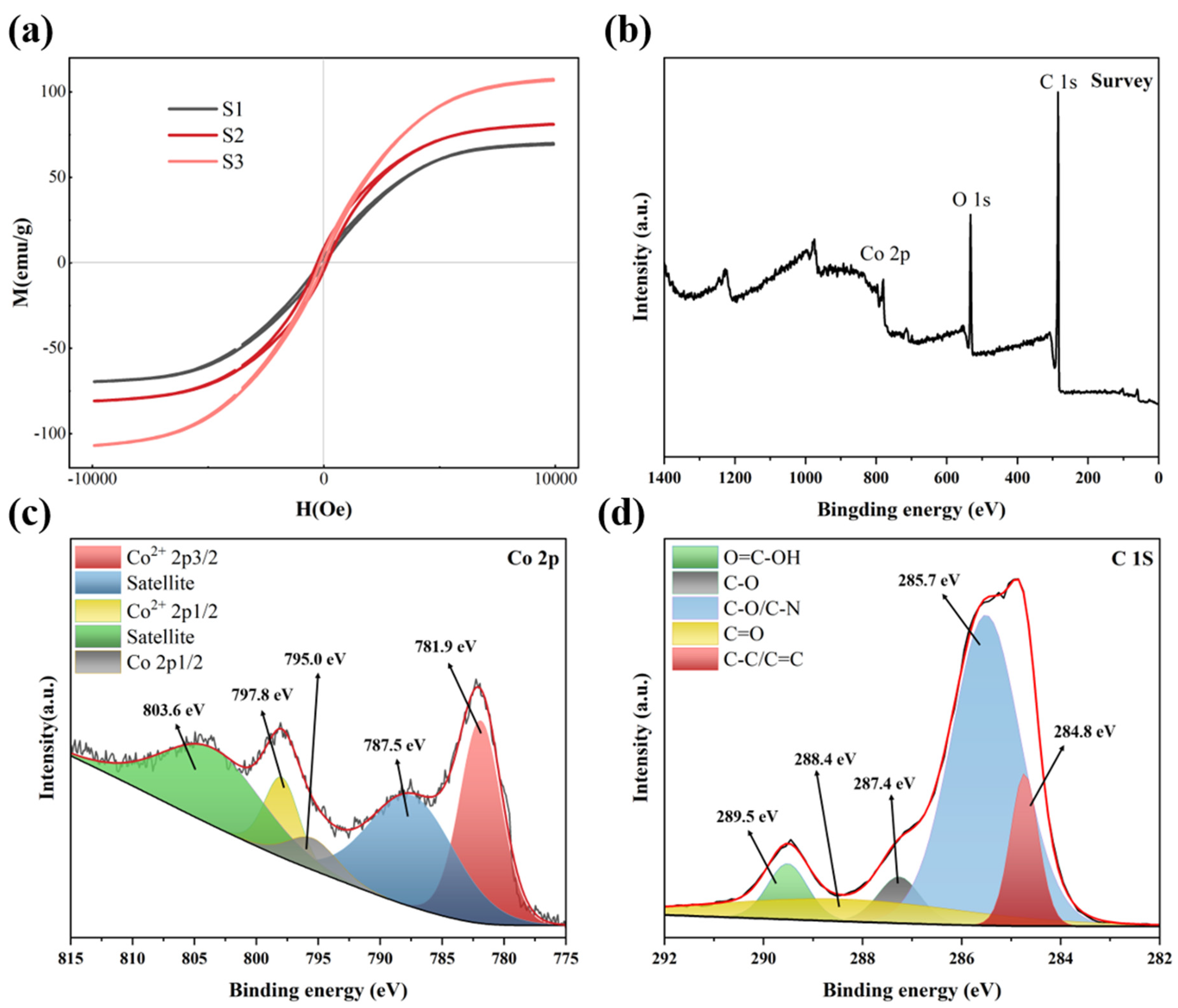
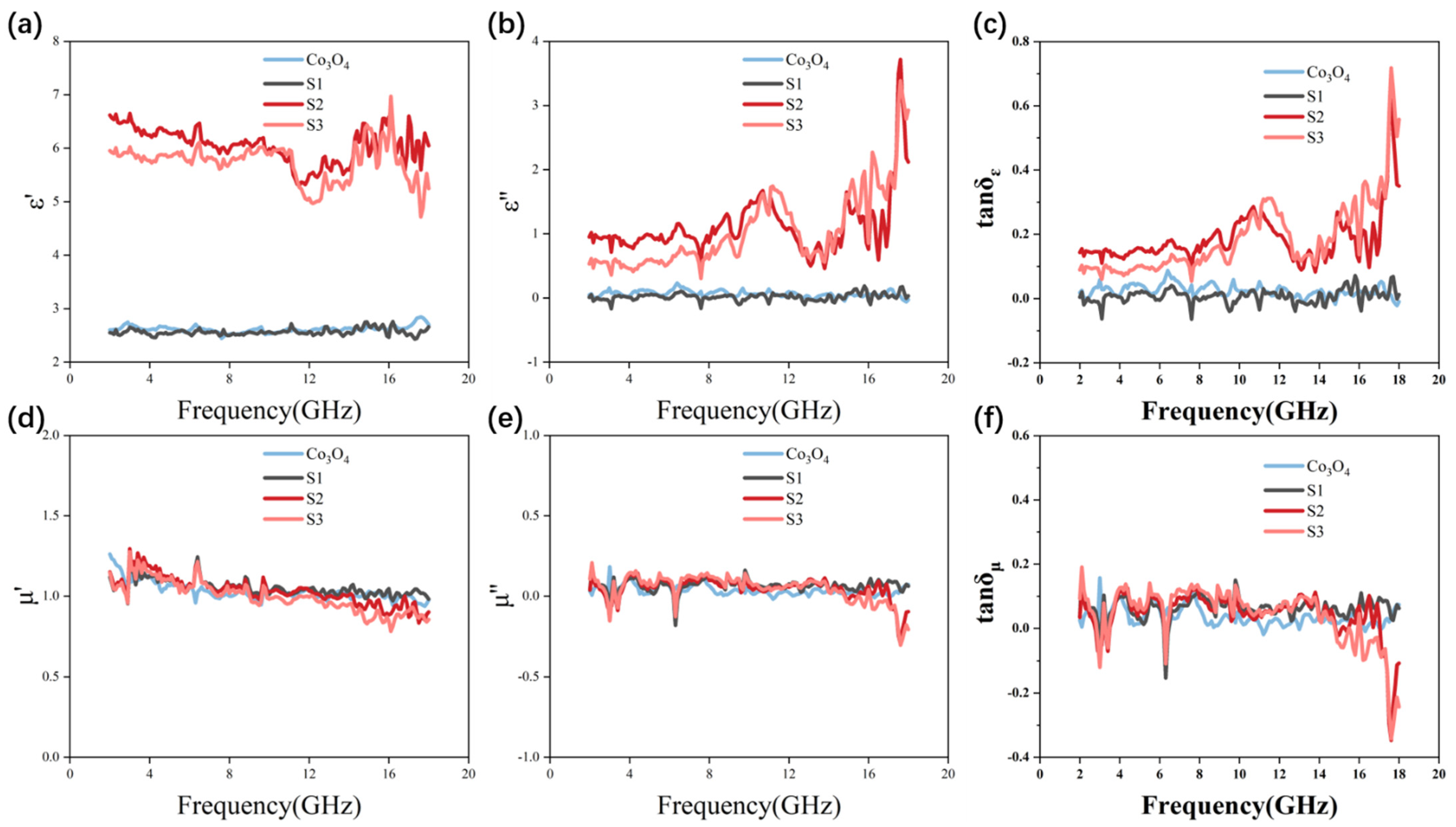
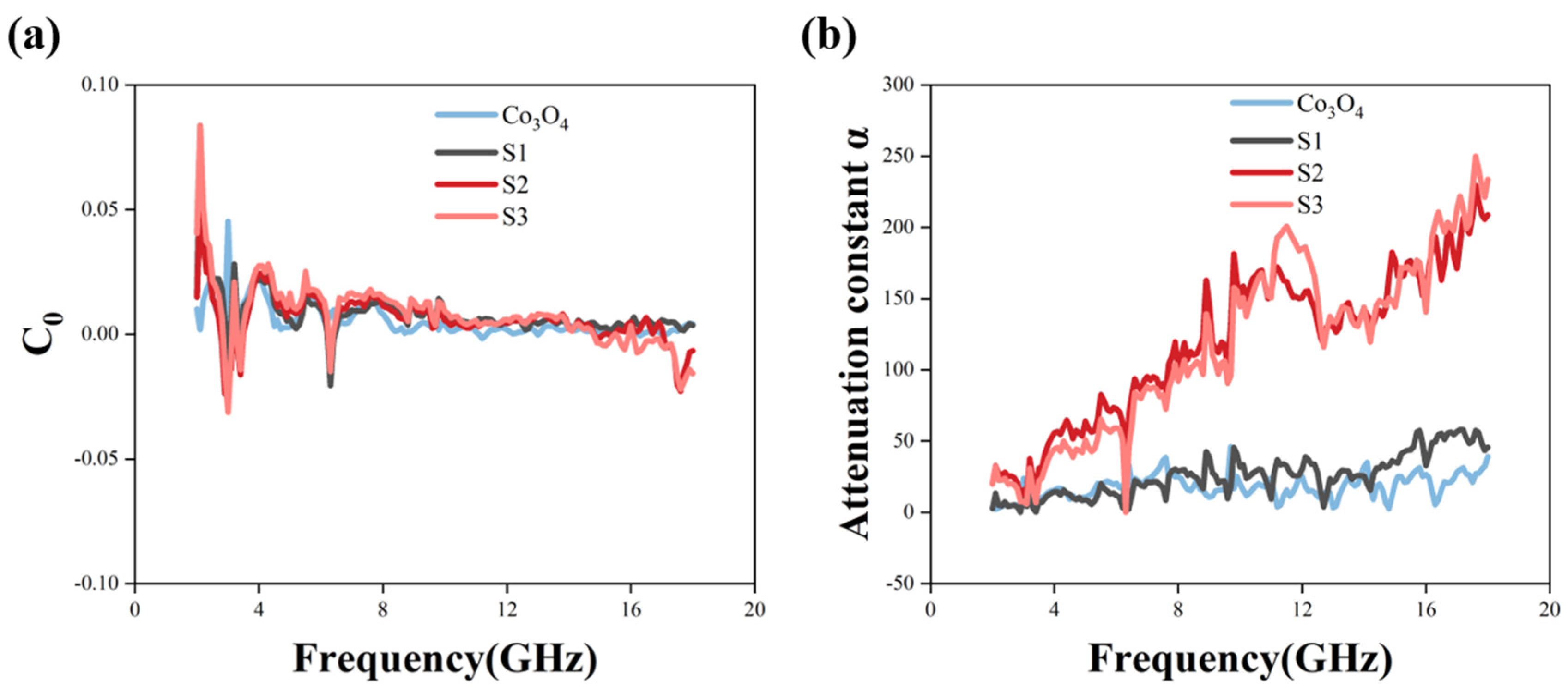

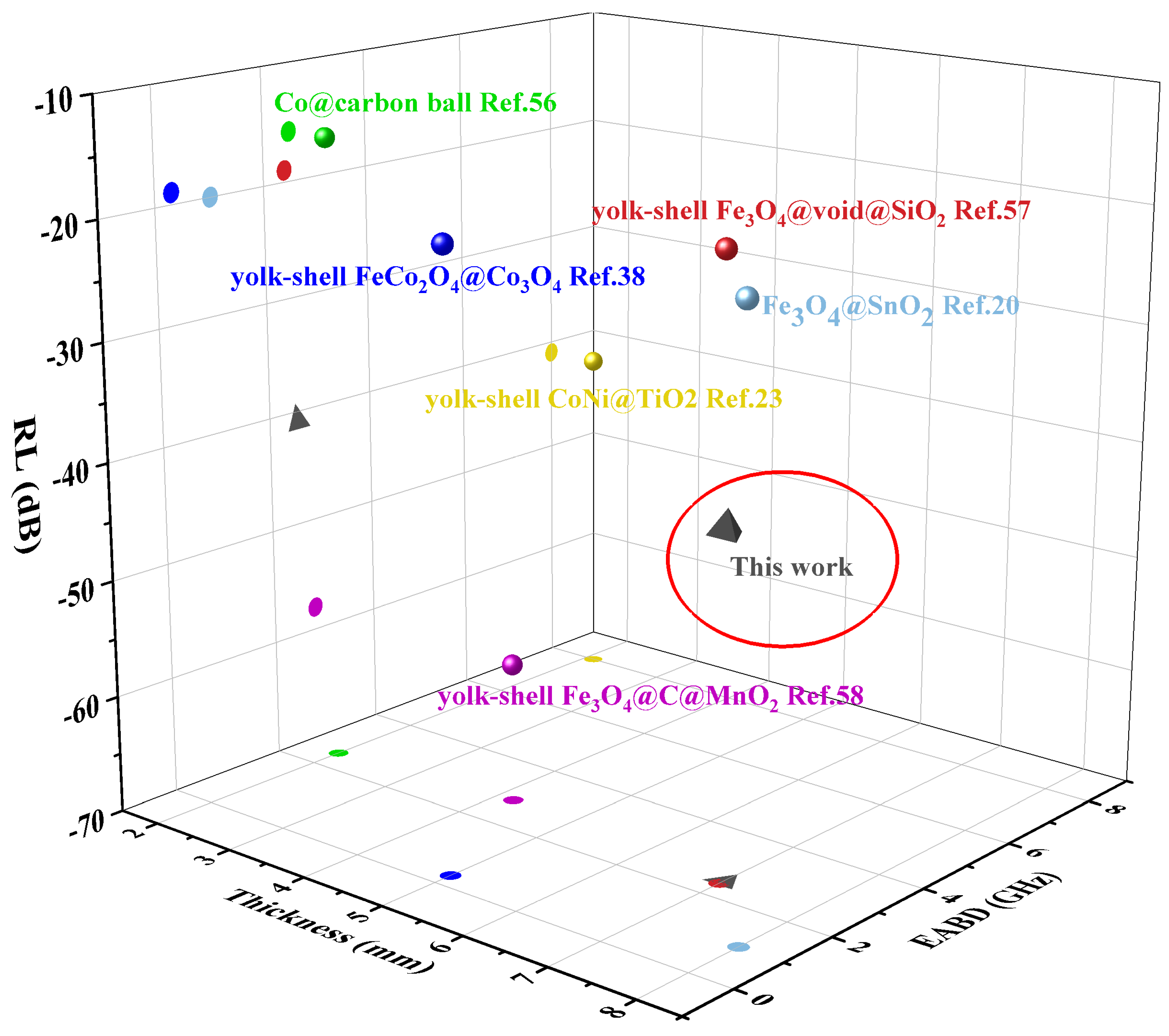
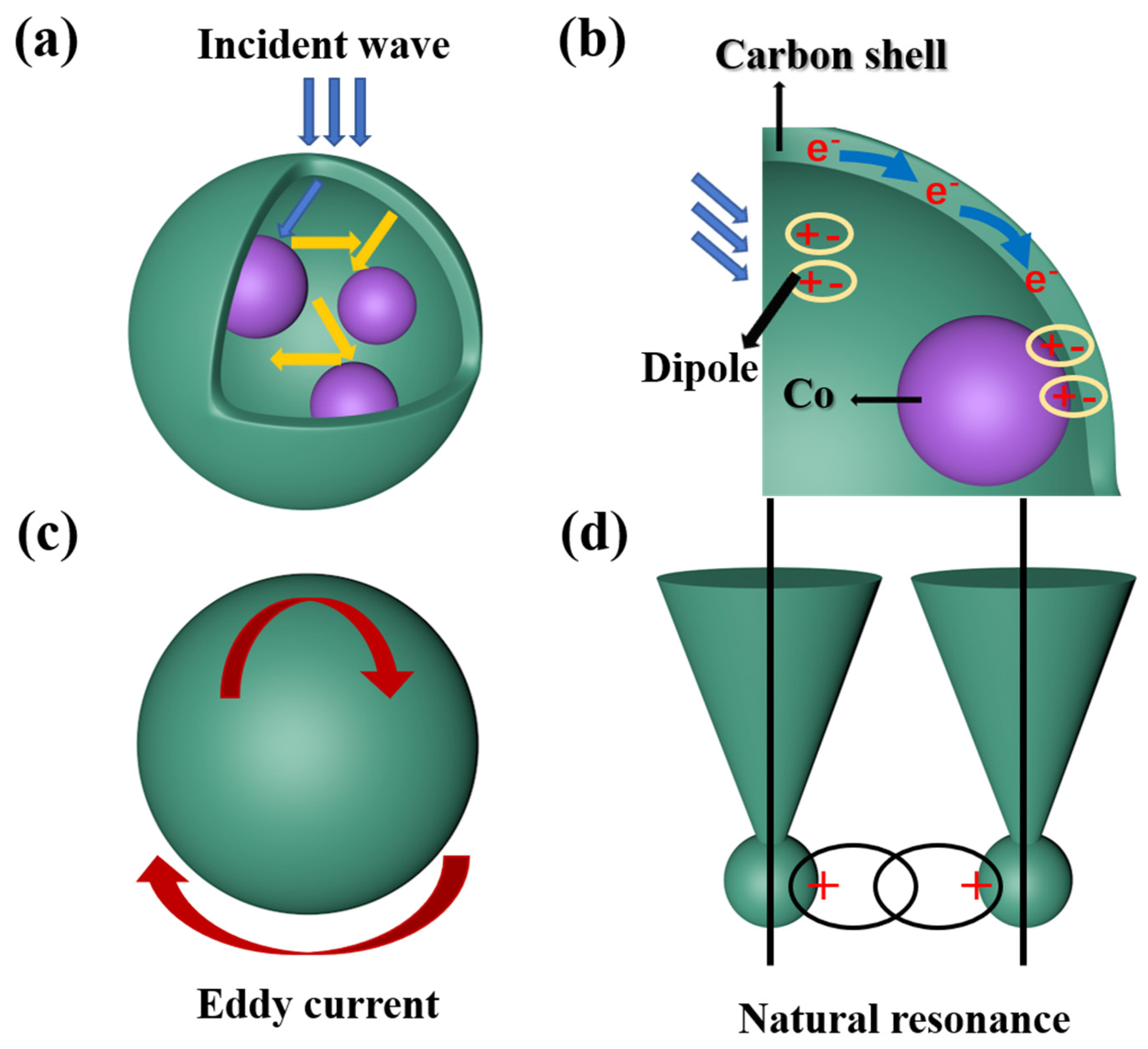
Publisher’s Note: MDPI stays neutral with regard to jurisdictional claims in published maps and institutional affiliations. |
© 2021 by the authors. Licensee MDPI, Basel, Switzerland. This article is an open access article distributed under the terms and conditions of the Creative Commons Attribution (CC BY) license (https://creativecommons.org/licenses/by/4.0/).
Share and Cite
Zhang, M.; Qiu, J.; Xin, Z.; Sun, X. In Situ Reduced Multi-Core Yolk–Shell Co@C Nanospheres for Broadband Microwave Absorption. Materials 2021, 14, 4610. https://doi.org/10.3390/ma14164610
Zhang M, Qiu J, Xin Z, Sun X. In Situ Reduced Multi-Core Yolk–Shell Co@C Nanospheres for Broadband Microwave Absorption. Materials. 2021; 14(16):4610. https://doi.org/10.3390/ma14164610
Chicago/Turabian StyleZhang, Mu, Jiahang Qiu, Zhen Xin, and Xudong Sun. 2021. "In Situ Reduced Multi-Core Yolk–Shell Co@C Nanospheres for Broadband Microwave Absorption" Materials 14, no. 16: 4610. https://doi.org/10.3390/ma14164610




